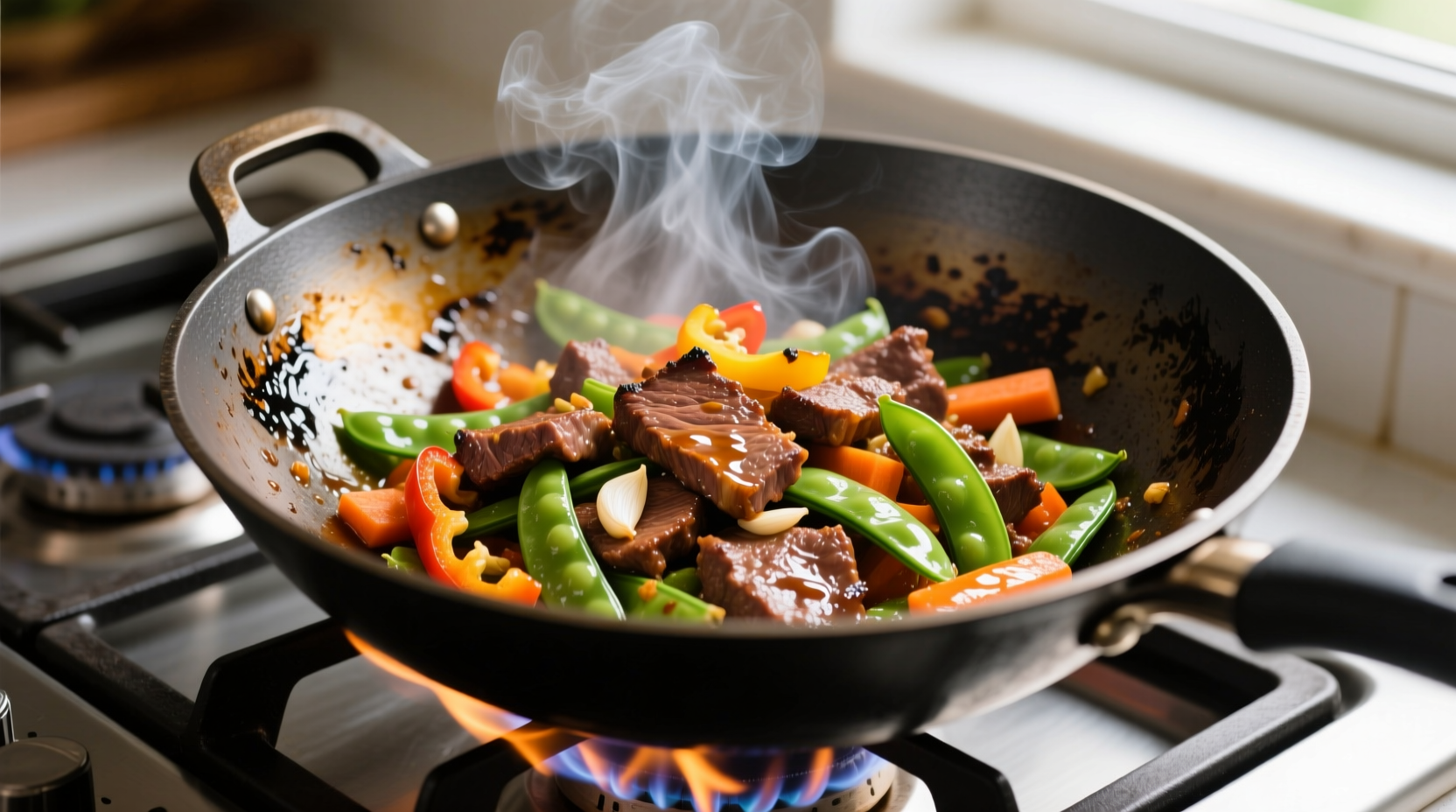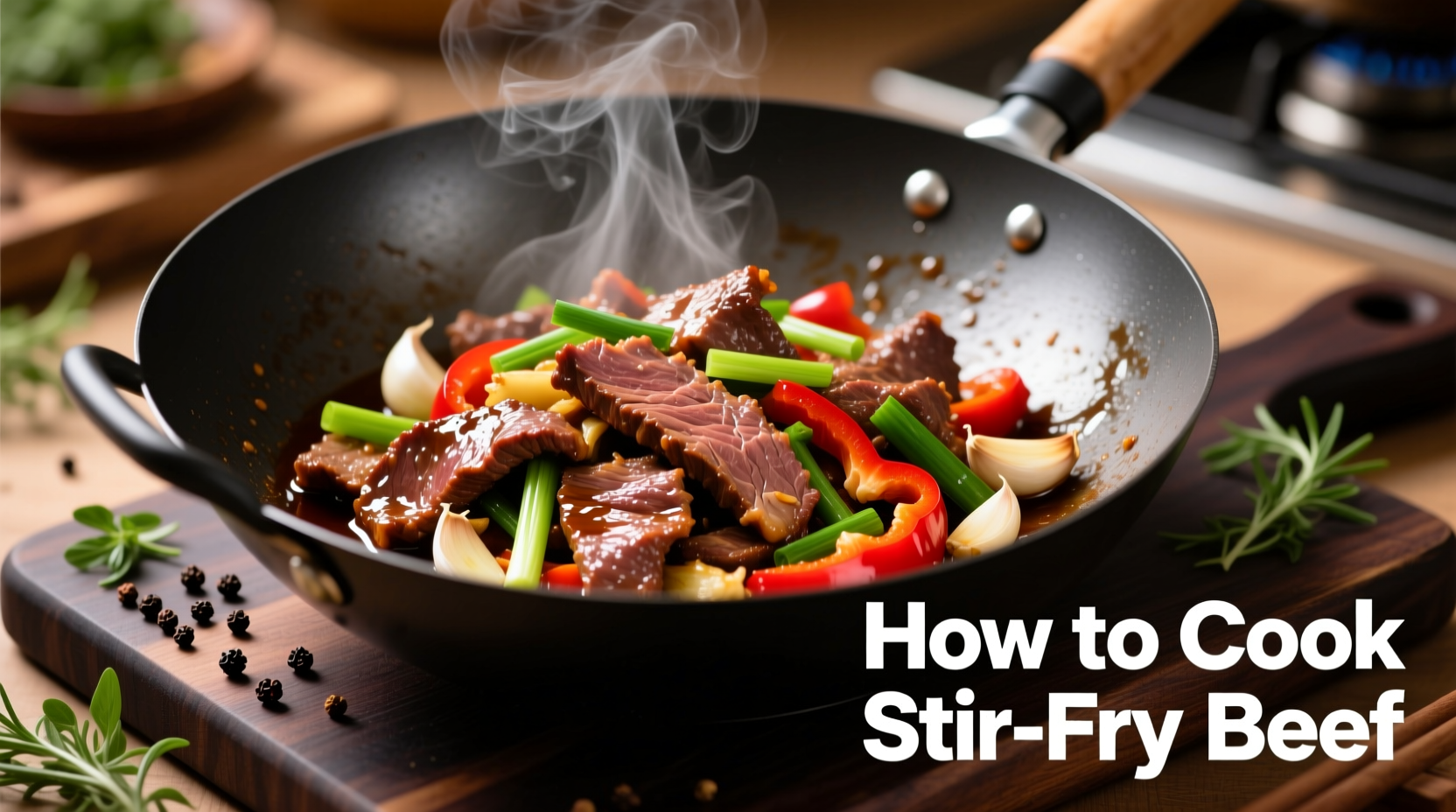The perfect stir fry beef recipe requires thinly sliced flank steak marinated in soy sauce, rice wine, and cornstarch, then cooked at extremely high heat for 90-120 seconds in a well-seasoned wok. Key success factors include proper meat selection, correct heat management, and precise timing to achieve tender, flavorful results without overcooking.
Why This Stir Fry Beef Method Actually Works
Most home cooks struggle with tough, chewy stir fry beef because they misunderstand the science behind the technique. Authentic Chinese stir fry relies on three critical elements: the velveting process (using cornstarch and egg white), proper heat management (maintaining 400-500°F), and correct meat selection. When these elements align, you'll achieve restaurant-quality results with tender, flavorful beef that absorbs sauce perfectly.
| Beef Cut | Texture After Cooking | Best For Stir Fry? | Preparation Tip |
|---|---|---|---|
| Flank Steak | Tender when sliced thin against grain | ★★★★★ | Must slice ¼-inch thick across grain |
| Sirloin | Moderately tender | ★★★★☆ | Velvet with cornstarch mixture |
| Ribeye | Rich but can become chewy | ★★★☆☆ | Trim excess fat before slicing |
| Round Steak | Often tough | ★☆☆☆☆ | Not recommended for traditional stir fry |
Your Stir Fry Beef Success Timeline: From Selection to Serving
Understanding the evolution of stir fry technique helps you appreciate why certain steps matter. Traditional Chinese stir fry developed during the Ming Dynasty when woks became widely available. The technique evolved to maximize limited fuel resources by cooking food extremely quickly at high temperatures. Modern adaptations include:
- 15th Century: First wok-based stir frying in China using wood/charcoal fires
- 19th Century: Technique spreads to Southeast Asia with Chinese immigrants
- 1960s: Introduction to Western home kitchens with affordable carbon steel woks
- Today: Modern adaptations for electric stoves and non-stick cookware
Beef Selection: The Foundation of Great Stir Fry
Not all beef works equally well for stir fry. Flank steak remains the gold standard because its muscle structure responds perfectly to the quick-cooking method when sliced correctly. According to USDA meat science guidelines, flank steak contains moderate marbling that melts during high-heat cooking, enhancing tenderness without making the dish greasy.
When selecting beef:
- Look for bright red color with fine marbling
- Avoid pre-cut "stir fry beef" from supermarkets (often poor quality)
- Buy whole cuts and slice yourself against the grain
- Chill meat slightly before slicing for cleaner cuts

The Critical 20-Minute Preparation Sequence
Professional results come from precise timing. Follow this sequence for optimal flavor development and texture:
- 0-5 minutes: Slice beef against the grain into ¼-inch strips
- 5-10 minutes: Prepare marinade (2 tbsp soy sauce, 1 tbsp rice wine, 1 tsp cornstarch, 1 tsp sesame oil)
- 10-15 minutes: Marinate beef while prepping vegetables
- 15-20 minutes: Make sauce (3 tbsp broth, 1 tbsp oyster sauce, 1 tsp sugar, 1 tsp cornstarch)
This timing ensures the cornstarch in the marinade has time to form a protective coating around the meat without becoming gummy.
Mastering the Cooking Technique: Heat Management Secrets
The most common mistake home cooks make is insufficient heat. Your cooking surface must reach 400-500°F before adding oil. Here's the professional sequence:
- Heat wok or heavy skillet until smoking slightly
- Add 1 tbsp high-smoke point oil (peanut or avocado)
- Swirl oil to coat surface evenly
- Add beef in single layer (work in batches if needed)
- Cook 90-120 seconds without stirring until seared
- Remove beef immediately to prevent overcooking
- Proceed with vegetables and sauce
Research from the Culinary Institute of America confirms that maintaining proper heat prevents the "steaming" effect that makes stir fry soggy. Electric stoves typically require preheating for 8-10 minutes to achieve adequate temperature.
Context Boundaries: When These Techniques Don't Work
Understanding limitations prevents frustration. This method works best with:
- Thinly sliced cuts: Not suitable for thick steaks or roasts
- High-heat cooking: Won't work on low-temperature induction cooktops without special adapters
- Fresh ingredients: Pre-marinated or frozen beef yields inferior results
- Immediate consumption: Stir fry doesn't reheat well due to texture changes
For those with standard home stoves, consider using a cast iron skillet as an alternative to traditional woks. According to food science research published in the Journal of Food Engineering, cast iron retains heat better than non-stick alternatives for stir fry applications.
Troubleshooting Common Stir Fry Problems
Even experienced cooks encounter issues. Here's how to fix them:
- Beef is tough: You sliced with the grain or overcooked. Solution: Always slice against the grain and cook for no more than 2 minutes.
- Sauce is watery: Cornstarch wasn't properly activated. Solution: Mix cornstarch with cold liquid before adding to hot sauce.
- Food sticks to pan: Heat wasn't high enough. Solution: Increase heat and ensure proper oil coating.
- Bland flavor: Insufficient seasoning or overcrowded pan. Solution: Cook in batches and balance salty/sweet elements.
Serving and Storage Guidelines
Stir fry is best served immediately while hot. For optimal presentation:
- Use a preheated serving dish to maintain temperature
- Garnish with sesame seeds or sliced green onions
- Serve over properly cooked jasmine rice (not sticky)
- Consume within 2 hours for best texture
If storing leftovers, separate beef from sauce to prevent over-marinating. According to USDA food safety guidelines, refrigerate within 2 hours and consume within 3-4 days. Reheat in a hot skillet rather than microwave to restore texture.
Advanced Flavor Variations
Once you've mastered the basic technique, experiment with these authentic regional variations:
- Sichuan style: Add 1 tsp Sichuan peppercorns and 2 dried chilies for numbing heat
- Cantonese style: Incorporate 1 tbsp fermented black beans for umami depth
- Hakka style: Include preserved vegetables for complex sour notes
- Modern fusion: Add 1 tsp gochujang for Korean-inspired flavor











 浙公网安备
33010002000092号
浙公网安备
33010002000092号 浙B2-20120091-4
浙B2-20120091-4